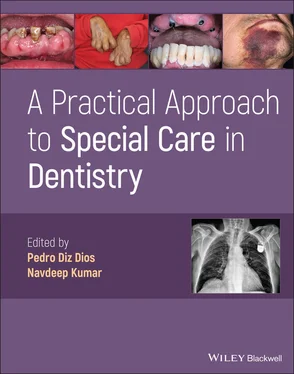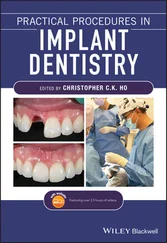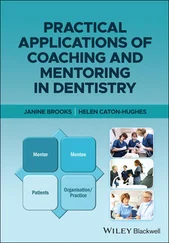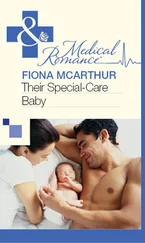A Practical Approach to Special Care in Dentistry
Здесь есть возможность читать онлайн «A Practical Approach to Special Care in Dentistry» — ознакомительный отрывок электронной книги совершенно бесплатно, а после прочтения отрывка купить полную версию. В некоторых случаях можно слушать аудио, скачать через торрент в формате fb2 и присутствует краткое содержание. Жанр: unrecognised, на английском языке. Описание произведения, (предисловие) а так же отзывы посетителей доступны на портале библиотеки ЛибКат.
- Название:A Practical Approach to Special Care in Dentistry
- Автор:
- Жанр:
- Год:неизвестен
- ISBN:нет данных
- Рейтинг книги:3 / 5. Голосов: 1
-
Избранное:Добавить в избранное
- Отзывы:
-
Ваша оценка:
- 60
- 1
- 2
- 3
- 4
- 5
A Practical Approach to Special Care in Dentistry: краткое содержание, описание и аннотация
Предлагаем к чтению аннотацию, описание, краткое содержание или предисловие (зависит от того, что написал сам автор книги «A Practical Approach to Special Care in Dentistry»). Если вы не нашли необходимую информацию о книге — напишите в комментариях, мы постараемся отыскать её.
Learn to treat dental patients with disabilities or who are medically compromised A Practical Approach to Special Care in Dentistry
A Practical Approach to Special Care in Dentistry
A Practical Approach to Special Care in Dentistry — читать онлайн ознакомительный отрывок
Ниже представлен текст книги, разбитый по страницам. Система сохранения места последней прочитанной страницы, позволяет с удобством читать онлайн бесплатно книгу «A Practical Approach to Special Care in Dentistry», без необходимости каждый раз заново искать на чём Вы остановились. Поставьте закладку, и сможете в любой момент перейти на страницу, на которой закончили чтение.
Интервал:
Закладка:
Drug treatment for tone/movement disorders, including baclofen, trihexyphenidyl, gabapentin, diazepam, clonidine and botulinum toxin
Neurosurgical interventions, including selective rhizotomy and electrode implantation in the basal ganglia
Epilepsy control, speech therapy and hearing and vision support
Special education and occupational therapy
Prognosis
The life expectancy for cerebral palsy may be reduced in relation to the number and severity of the associated disabilities Figure 1.1.5 (a) Spastic cerebral palsy. (b) Hand deformity calls for adaptive tools (e.g. adapted toothbrush handle).
If gross and fine motor functioning, independent feeding, mental and visual capacities are severely impaired, survival to 40 years of age may be as low as 40%
Causes of early death may include pulmonary aspiration and pneumonia, accidents, associated disorders (e.g., congenital heart disease) and delayed recognition of illness
A World/Transcultural View
The prevalence of cerebral palsy is estimated at 1.9/1000 live births in China, 2.1/1000 in Europe and 3.6/1000 in the US. This variability is probably an expression of the predominant aetiological factors. For example, cerebral palsy among the Jewish population is due mostly to premature births, while among the Arab population, the condition is especially attributed to consanguinity and genetic factors
In low‐ and medium‐income countries such as India, there are educational and healthcare deficiencies in terms of the principles of the International Classification of Functioning, Disability and Health, while in higher‐income countries such as Canada, the parents of children with cerebral palsy perceive a more conducive environment and express a more social outlook on their children's health
Recommended Reading
1 Abeleira, M.T., Outumuro, M., Diniz, M. et al. (2016). Orthodontic treatment in children with cerebral palsy. In: Cerebral Palsy – Current Steps (ed. M.K. Gunel), 129–140. Rijeka, Croatia: Intech.
2 Bensi, C., Costacurta, M., and Docimo, R. (2020). Oral health in children with cerebral palsy: a systematic review and meta‐analysis. Spec. Care Dentist. 40: 401–411.
3 Cahlin, B.J., Lindberg, C., and Dahlström, L. (2019). Cerebral palsy and bruxism: effects of botulinum toxin injections‐a randomized controlled trial. Clin. Exp. Dent. Res. 5: 460–468.
4 Cardoso, A.M.R., de Medeiros, M.M.D., Gomes, L.N. et al. (2018). Factors associated with health and oral health‐related quality of life of children and adolescents with cerebral palsy. Spec. Care Dentist. 38: 216–226.
5 Colver, A., Fairhurst, C., and Pharoah, P.O. (2014). Cerebral palsy. Lancet 383: 1240–1249.
6 Jan, B.M. and Jan, M.M. (2016). Dental health of children with cerebral palsy. Neurosciences. 21: 314–318.
7 Rai, T., Ym, K., Rao, A. et al. (2018). Evaluation of the effectiveness of a custom‐made toothbrush in maintaining oral hygiene and gingival health in cerebral palsy patients. Spec. Care Dentist. 38: 367–372.
8 Vpk, V., Mohanty, V.R., Balappanavar, A.Y. et al. (2020). Effectiveness of different parenting interventions on oral hygiene of cerebral palsy children: a randomized controlled trial. Spec. Care Dentist. 40: 335–343.
1.2 Epilepsy
Section I: Clinical Scenario and Dental Considerations
Clinical Scenario
A 17‐year‐old female presents to an emergency hospital department following facial trauma experienced during an epileptic seizure ( Figure 1.2.1). She complains of pain and mobility in the maxillary central incisors. Your dental opinion is sought.
Medical History
Refractory epilepsy (3–5 seizures a day with variable presentation, including generalised tonic–clonic seizures). The patient is awaiting assessment for inserting a vagus nerve stimulator
Delayed psychomotor development
Intellectual disability (moderate)
Medications
Ethosuximide
Lamotrigine
Clonazepam
Sodium valproate
Dental History
Seizures resulting in repeated trauma in the orofacial region – deciduous and permanent dentition affected
Limited co‐operation – only dental examinations possible in the past; no previous dental radiographs or dental treatment undertaken
Patient brushes her teeth twice a day, supervised by her mother
Social History
Lives with her parents and a younger sibling
During the day, the patient attends an occupational therapy centre
Patient requires help for basic activities of daily life
Oral Examination
Mucosal scarring from previous seizure‐related trauma
Displacement, proclination and significant mobility of the maxillary central incisors ( Figure 1.2.2)
Localised areas of gingival enlargement
Radiological Examination
Not performed due to lack of co‐operation
Structured Learning
1 The decision was made to undertake a detailed examination and deliver any required dental treatment under general anaesthesia in a hospital setting. Why?The patient's epilepsy is not under controlThe patient's degree of co‐operation is limited due to intellectual impairment
2 What factors are important to consider when assessing the risk of managing this patient?SocialAvailability of escorts/family to accompany the patient (younger sibling requires supervision)Capacity assessment required: if the patient is assessed as lacking capacity in relation to the proposed procedure, a best interest decision will be required; this should involve family members, social services, any health and social care professionals involved with the adult's care, carersDeprivation of Liberty standards cannot be applied if the patient is admitted as she is below the age of 18 years oldFinancial means (insurance coverage) to cover the costs of treatment in a hospital setting under general anaesthesia (varies between countries)MedicalIncreased risks in general associated with general anaesthesia Figure 1.2.1 Patient with uncontrolled epilepsy wearing a protective headgear. Figure 1.2.2 Severe displacement of the maxillary central incisors following facial trauma.High risk of seizures perioperatively due to the refractory epilepsy; hence inpatient bed and neurology support needed during admissionDentalUrgency of dental treatment (due to pain/mobility of anterior teeth) – cannot be delayed until the patient may be more stable after the vagus nerve stimulator is placedHigh risk of further dental traumaRisk of caries related to the oral dryness induced by the anticonvulsant drugsLimited efficacy of brushing exacerbated due to the gingival enlargement (secondary to ethosuximide, sodium valproate, lamotrigine)Potential bleeding tendency (sodium valproate)Difficulty following up the patient due to her lack of co‐operation
3 You determine that it is likely the displaced incisors will need extraction. Why is a full blood count and coagulation test advisable prior to this?Routine preoperative full blood count testing for patients undergoing general anaesthesia is mandatory in most countriesThe patient is taking sodium valproate: this can cause blood dyscrasias, including thrombocytopenia, aplastic anaemia, pure red cell aplasia, macrocytosis, neutropenia, and bleeding disorders (coagulation defects)
4 During the best interest discussion, the patient's family insists that prosthetic rehabilitation is performed during the same general anaesthetic session as any dental extractions. Why is this not recommended?There is a high risk of dental prosthetic fracture due to further traumaIt is advisable to delay this procedure until the epilepsy is controlled (at least wait until the efficacy of the vagus nerve stimulator has been observed)It is also preferable to wait until the remodelling of the bone crest is complete and to rule out damage of the contiguous teeth
Читать дальшеИнтервал:
Закладка:
Похожие книги на «A Practical Approach to Special Care in Dentistry»
Представляем Вашему вниманию похожие книги на «A Practical Approach to Special Care in Dentistry» списком для выбора. Мы отобрали схожую по названию и смыслу литературу в надежде предоставить читателям больше вариантов отыскать новые, интересные, ещё непрочитанные произведения.
Обсуждение, отзывы о книге «A Practical Approach to Special Care in Dentistry» и просто собственные мнения читателей. Оставьте ваши комментарии, напишите, что Вы думаете о произведении, его смысле или главных героях. Укажите что конкретно понравилось, а что нет, и почему Вы так считаете.












